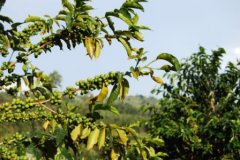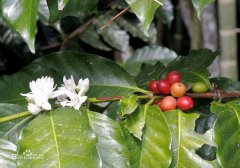Bourbon variety PB coffee beans African Gilimaza Tanzania Kilimanjaro Pearl
The coffee producing areas of Tanzania are Moshi, Mbeya and other producing areas around the foothills of Kilimanjaro in the north, and the Songea-Ruvuma area where the Ruvuma river flows to the south. The style is slightly different due to the different growth topography. The coffee produced in the Ruvuma region of southwestern Tanzania has wine and fruit aromas, which is different from that in the north near Mount Mt Kilimanjaro.
Mount Kilimanjaro is in the northeast of Tanzania, the largest coffee producing area in Tanzania, which accounts for 75%. In general, coffee beans in Tanzania have extraordinary quality. The important producing areas are in the mountains near Kenya in the north. Coffee farmers grow coffee 85% of the total, while local coffee farmers grow coffee at an altitude of 1300-2000m. Its coffee flavor is different from that of neighboring Ethiopia and Kenya. It has two national characteristics, thick body, good fruit and flower aroma, so it is worth a try. Coffee belongs to dicotyledonous plants. Generally speaking, there are two pairs of coffee seeds in a coffee cherry fruit, which is what we call coffee beans. Compared with pair of flat-sided beans, also known as caracol or caracolillo, it means little snail in Spanish. The production of round beans, botanically, is said to be due to uneven pollination (Arabica coffee is a self-pollinating plant, and if a coffee flower has only one ovary or only one ovary has successfully pollinated, it can only produce one seed). Or uneven nutrition during growth (usually more likely to occur in the coffee fruit growing at the end of the coffee tree), the nutrients are absorbed by only one of the cotyledons Only the cotyledons that get the nutrients and continue to grow grow into a single oval, oval-shaped coffee seed, hence the name of the round bean. Normally, the proportion of round beans produced by coffee plants is about 3 to 5%, which is relatively rare, and because the shape and size of coffee beans are different from those of normal coffee (flat) beans, round beans are often singled out and sold independently.

Important Notice :
前街咖啡 FrontStreet Coffee has moved to new addredd:
FrontStreet Coffee Address: 315,Donghua East Road,GuangZhou
Tel:020 38364473
- Prev

Grade G1 original species of snow caffeine from Worka estate in Waka, Ethiopia
Today, there are still a large number of wild Arabica coffee trees growing in many parts of Ethiopia, averaging between 4200 and 6800 feet above sea level. Now there is a trend of small cultivation, generally planting banana trees for shade at the same time, but due to lack of agricultural technology, herbicides and pesticides are less used. Coffee is Ethiopia's main economic crop and the largest in the country.
- Next

Nyeri Central Dashan area of Jiatugi processing Plant in Nyeri production area of Kenya
According to botanists in SL laboratory, SL28 and SL34 are genetic variants. Among them, SL28 has a mixed pedigree of French missionaries, mochas and Yemens Tibica. The goal of cultivating SL28 was to mass produce coffee beans with high quality and resistance to diseases and insect pests. Although the later production of SL28 was not as large as expected, copper leaves and broad bean-shaped beans were very popular.
Related
- What documents do you need to go through to open a coffee shop? coffee shop coffee shop certificate processing process
- How to purchase Coffee beans in small Cafe how to choose a suitable supplier for domestic Coffee supply Company
- How to drink Starbucks Fragrance White Coffee? how to make Australian White Coffee? what Italian coffee beans are recommended?
- The Story of Flora Coffee: the name of Flora Coffee Bean and the implication of the Flowers on Florna Coffee
- How much does a cup of coffee cost? How much is the profit of a cup of coffee? What is the profit of the coffee shop in a year?
- Yunnan small Coffee, known as "fragrant Coffee", introduces the characteristics of Alpine Arabica Coffee producing areas in Yunnan, China
- 2023 latest Starbucks full menu price list how much is a cup of Starbucks coffee what is better to drink the most popular hot and cold drinks recommended
- Starbucks different kinds of Coffee Price list Starbucks menu 2023 Top Ten Best drinks in Starbucks
- Starbucks Spring praise Comprehensive matching Coffee Bean theme Story Packaging implication and taste description
- The cost of a cup of coffee latte American coffee cost price and selling price

